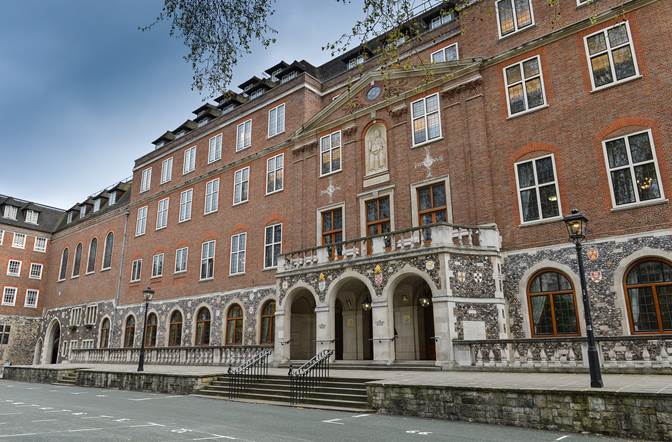The UK has some of the largest exhibition halls in Europe and hosts some of the biggest tradeshows. If you are trying to break into the UK market, exhibiting at a tradeshow is a great place to start. Some shows held in London at Excel or Olympia, or in Birmingham at the NEC attract hundreds of thousands of attendees from all over the world.
But there are some differences between tradeshows in the UK and in the US. Here we have a guide to UK exhibiting.
1. Booking a booth
You will have the option of space-only or shell scheme. Space-only is exactly that, just a marked-out area of bare floor. You will have to erect walls, supply flooring, arrange lighting, and ensure there is power delivered to the booth. Remember that the space is measured in meters (2.5 ft) rather than feet.
A shell scheme is a booth that is set up with walls, flooring, lighting and power already supplied. It is similar to a pipe and drape, but the walls are solid and the same height as the back. You are able to attach graphic panels to shell scheme walls to decorate the booth. You can also have an exhibit within the walls too. Shell schemes generally have a ceiling grid with a fascia board bearing your company name, but you can ask for this to be removed if the height of your exhibit is greater than the ceiling.
Shell schemes tend to be located around the edges of the hall and along the aisles. The space-only booths are usually the biggest ones in the center of the hall.
2. Cost
UK venues typically charge £30 – £35 per square foot for booth space, though it can vary depending on the venue. If you want to source a stand in the UK it will cost from around £4000 onward, depending on the size and complexity.
There are no drayage charges in the UK and no union labor rules. Therefore you can assemble the booth yourself, or your tradeshow contractor can do it for you. Bear in mind hotels, restaurants and transport are often more expensive in the UK, so you may find staying extra nights in order to build your booth isn’t worth it! But exhibiting generally is cheaper without the drayage or individual labor costs.
You will need to pay the tradeshow organizer’s contractors for supplying power and water to your booth, this is usually around £200. Be aware that the sockets are different in the UK so you will need 3 pin adaptors. The voltage is also different, you may need transformers to suit the UK’s voltage level of 220V/ 50 Hz if using 110V/60Hz booth equipment from the USA.
If you or your staff are hiring cars you will need to arrange parking at the venue, which will be an additional cost, usually around £10 a day.
You will find that AMEX isn’t widely accepted in the UK, larger companies will take it, but smaller shops, restaurants and companies will not, you will need Visa or Mastercard.
3. Logistics
You can freight your stand over to the UK, but there is a risk it could get damaged or lost in transport and there may be delays at Customs. It may be better to hire a stand from a contractor in the UK. They can then transport it to the trade show, assemble it, and then dismantle it at the end. This will save you a lot of hassle – remember they drive on the left! Contractors like Quadrant2Design will hire a booth for free, you just pay for the graphic panels. They will also take care of all the form-filling and make sure all services are supplied to the booth, saving you the effort.
If you want to do it yourself, you will need to get your booth transported to the venue a day or two before the show. There will be a separate entrance for vehicles setting up, you can usually drive right up to the hall.
4. Health and Safety
This is a big thing in the UK and to abide by regulations health and safety forms and a risk assessment need to be completed for every booth. If you are using a contractor like Quadrant2Design they will do it for you. Otherwise you need to make sure you complete the correct forms required by the organizer and ensure that everything in your booth complies.
If you plan to hang items from the ceiling, use big lighting rigs or other potentially hazardous equipment, you can expect to have it carefully inspected by a health and safety officer from the venue.
5. Networking
Tradeshows are a great place to make new contacts that can help your business expand. There will probably be specific networking sessions at the trade show which you can sign up for.
But much of the networking opportunities in the UK take place at the end of the day, in the venue’s bars and restaurants. So it’s a good idea to stay in a hotel as close to the venue as possible so that you can join in. Be aware that some of the major venues, like NEC Birmingham and London Excel are quite a long way from the city centers so go for a hotel onsite rather than in the center.
6. Attire
Tradeshows in the UK are not generally formal affairs. Smart/casual business clothing will be the most appropriate. Remember the weather can be changeable and cool, even in the summer so take several layers, tradeshow halls can be cold.
7. Terminology
In the UK a tradeshow is often called an exhibition. Tradeshow booths are exhibition stands. A back-loader truck is a low-loader lorry. A decorator and display builder are both referred to as an exhibition stand contractor. A rental booth is exhibition stand hire.
8. COVID rules
You do not need to fill in a passenger location form, prove vaccination status, take a COVID test or quarantine when traveling to the UK. There are also no formal requirements to wear masks at indoor venues, though many still wear them on public transport. Some events may ask for proof of vaccination, check individual websites for confirmation.
For more useful information like this, follow Quadrant2Design.
































